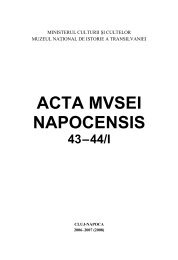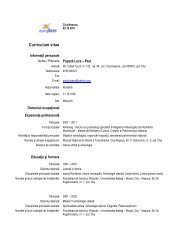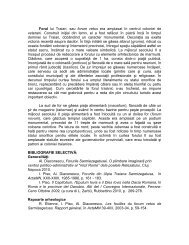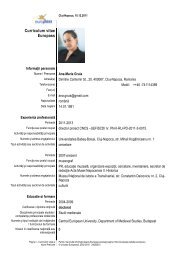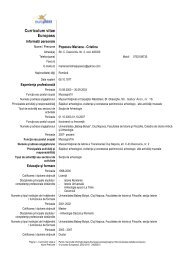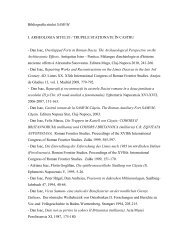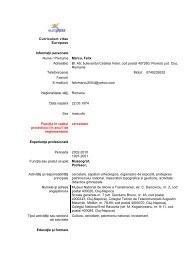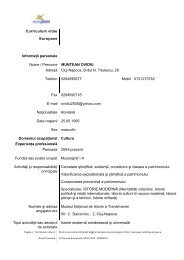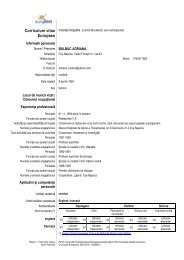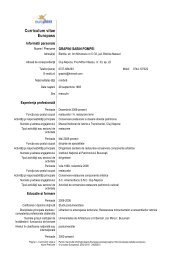41-42/I – Archeology - Muzeul Naţional de Istorie a Transilvaniei
41-42/I – Archeology - Muzeul Naţional de Istorie a Transilvaniei
41-42/I – Archeology - Muzeul Naţional de Istorie a Transilvaniei
You also want an ePaper? Increase the reach of your titles
YUMPU automatically turns print PDFs into web optimized ePapers that Google loves.
6<br />
Gheorghe GâŃă, Alexandru Dragoman<br />
terrace, one of the medium terraces of the Danube. To the north Dealul Cişmelei is<br />
bor<strong>de</strong>red by the Obârşia stream flowing from west to east 4 . Today, Măgura is almost<br />
round-shaped with a north-south diametre of 54.50 m and the east-west one of 50.50 m<br />
and a height of 1.40 m. The altitu<strong>de</strong> from the sea level is 82.50 m and 12-14 m above the<br />
Obârşia stream meadow 5 .<br />
State of research<br />
As resulted from the excavations reports, the main goal of those who conducted<br />
the excavations in the settlement of Vădastra<strong>–</strong>Măgura Fetelor was establishing and later<br />
checking the relative chronology of the site. The settlement was first surveyed by Vasile<br />
Christescu in 1926 6 . As Christescu’s excavations failed to lead to any conclusions from a<br />
stratigraphical point of view, in 1934 Dumitru Berciu conducted new surveys 7 , that led to<br />
the i<strong>de</strong>ntification of two Neolithic layers which he named Vădastra I (characterized by<br />
channelled pottery) and Vădastra II (characterized by excised pottery). According to<br />
Berciu one cannot make a clear distinction between the two layers. The pottery<br />
<strong>de</strong>corated with channellings occurs also in the lower levels of layer II, where it associates<br />
with the excised pottery, but later <strong>de</strong>creases and vanishes 8 . The excavations were<br />
resumed in 1946 by Corneliu N. Mateescu, who continued the researches <strong>–</strong> with some<br />
interruptions <strong>–</strong> until 1974 9 . The anthropogenic <strong>de</strong>posits are about three meters thick in<br />
the center of the hillock, getting thinner and thinner (till 0.50 m thick) as the hillock gets<br />
farther. Mateescu provi<strong>de</strong>d the following stratigraphic sequence:<br />
1. Paleolithic layer with a maximum thickness of 0.60 m 10 .<br />
2. ‘Medium layer’ with no archaeological material <strong>–</strong> with a maximum thickness of<br />
0.45-0.50 m.<br />
3. Vădastra I layer (Neolithic): 0.40-0.04 m thick, perva<strong>de</strong>d by many later pits<br />
(Vădastra II: some of them are 3.50 m in diameter and 1.50 m <strong>de</strong>ep), the very reason<br />
why the material is mixed to a large extent. In this layer he uncovered ‘pit-houses’, pits,<br />
as well as a ditch suposed to have surroun<strong>de</strong>d the settlement.<br />
4. Vădastra II layer (Neolithic): 0.80-0.06 m thick and could have had more<br />
levels, that were not noticed. In this layer he uncovered a two-room house with a<br />
verandah built of a pole skeleton with wattle bound with clay, remains from other<br />
<strong>de</strong>stroyed houses built in the same way, many pits, a kiln etc.<br />
5. SălcuŃa layer (Copper Age) with a thickness of 0.65-0.05 m. On Măgura<br />
Fetelor, the upper part of this layer has been <strong>de</strong>stroyed by ploughing and erosion.<br />
6. Mediaeval Age dwelling traces: the XIV th , XVII th and XVIII th centuries 11 . The<br />
lower part of this layer has been preserved on the terrace.<br />
The analyses of the soil samples taken from the excavations conducted in 1965<br />
on Măgura Fetelor 12 proved that, from top to bottom, in the culture layers the clay ranges<br />
between 20 and 33 %. The loess in the ‘medium layer’, the Paleolithic one and that from<br />
the ‘live soil’ is richer in clay (the proportion is 33 %) than that in the Neolithic layers. At<br />
the same time, the plasticity ratio of the ‘medium layer’ and of the Paleolithic one has<br />
4 Mateescu 1970b, p. 67.<br />
5 Mateescu 1970a, p. 52.<br />
6 Christescu 1927-1932, p. 169-205.<br />
7 Berciu 1934, p. 75-79; 1937, p. 1-9.<br />
8 Berciu 1937, p. 4.<br />
9 Mateescu 1949; 1959a; 1959b; 1961a; 1961b; 1962a; 1962b; 1965; 1970a; 1970b; 1970c; 1972;<br />
1973; 1978; Protopopescu-Pake et al. 1969, p. 136-149.<br />
10 See Păunescu 1999-2000 with the previous literature.<br />
11 See Mateescu 1960; 1963; 1968; 1970d; Mateescu, Comănescu 1972; 1973; Comănescu, Mateescu<br />
1970; 1970-1971.<br />
12 Protopopescu-Pake et al. 1969, p. 151-152.



